Cranes in France
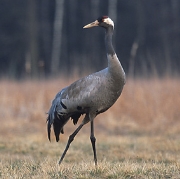


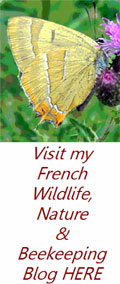

Crane Grus grus Grue Cendrée
The Common Crane is
one of the largest birds in
Cranes are very
sociable and gregarious during their migration and wintering when they
can form very large groups, especially on the ground which can be many
tens of thousands. They are however extremely territorial when nesting.
Breeding grounds are
situated principally in
Here a couple will produce one or two eggs in
May that take about 4 weeks to hatch.
Shortly after
hatching, the chicks are able to follow their parents and sneak into the
swamp in search of insects, molluscs and small vertebrates which then
make up the bulk of their food. Thereafter, they consume more plants:
tender herbs, aquatic plants and berries. The young start to take to the
air at around two months between mid July and August when they have to
prepare for their first migration when they will stay with their parents
until their return in the spring. Sexual maturity isn’t actually
achieved for between 3 and 5 years when, assuming they find a partner,
they pair for life.
In August and September thousands of cranes gather on the Swedish island of Oland from here they can cross the Baltic sea to the Island of Rügen where around 30000 birds gather in October with about another 15,000 on the German mainland with the birds moving through in groups, arrivals and departures staying perhaps two or three days, possibly longer. As with all things natural nothing is precise and much is determined by weather and temperature. It is access to food on the ground that is most important both during their migration and where they over winter. What we can say is that the main migration is October to December with small movements from September and possibly continuing sporadically until early Spring and that therefore the “migration” is both gradual and partial, spread out over several months with them wintering at various locations stretching from north-eastern France (Lorraine and especially Champagne) to Morocco with various locations in between, however the majority will end up in Spain with most of them in the large wintering areas of Extremadura.
Map for autumn migration in France
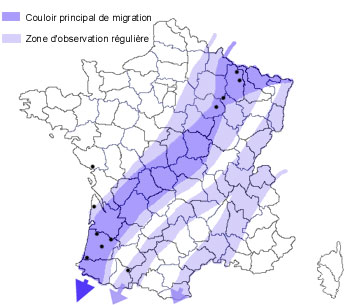
Although this site is
concerned with France it should be mentioned that to the East there is
another European migratory route taking birds through the Great
Hungarian plain then southward from Hungary that is generally described
as crossing the Balkan Peninsula on two routes: one over the Adriatic
Sea, and a second, more easterly route via Bulgaria, Greece and the
Aegean to North and East Africa.
The map shows the principle breeding zones and the migratory corridors.
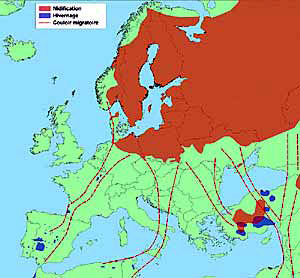
Most estimates of flight speed puts them at
between 40 to 80 km/h (depending on the wind). On at least one occasion
I have followed a flock on a straight road at 80 to 90 km/h.
On migration they will fly by night and by
day with altitudes between 200 to 1000 meters. This is quite important
and worthy of note as this height clears the wind generators at 150 metres although in practice they may occasionally drop below this height
before circling and regaining altitude.
Starting in late
January the Spring migration starts with some small movements, sometimes
being reversed due to cold weather but once it gets underway it is a far more rapid affair with all the
urgency that breeding brings with it. This tends to peak in March with
the route being slightly shifted to the east, however the same areas are
used during stops although many will cross
Map shows spring migratory corridors.
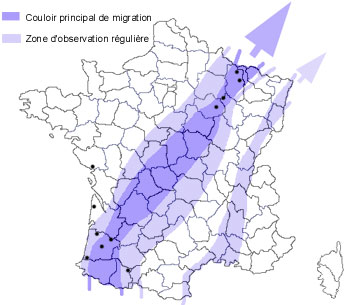
In
With a west European
population of 250,000 and a total European population of 400,000 they
are relatively OK but, (there is as always a BUT), issues remain with
serious threats principally habitat loss and lack of winter feeding
grounds.
Hunting and
destruction of nesting sites (dry marsh) were sufficient to eliminate
the breeding Crane populations of the southern half of
Transformation of
over-wintering sites by deforestation where Spanish oak acorns provided
the main food supply.
Dependence on
increasingly large scale agricultural production resulting in poisoning
and infertility caused by the massive use of hazardous chemicals -
nothing really new there!
Drainage and exploitation of northern forests
destroying parts of their nesting areas.
Agri-environmental
conservation measures that had been put in place decreasing again.
The Common Cranes
primarily use large lakes and reservoirs as dormitories and eat in the
fields around, especially in corn stubble in the Autumn.
Conservation measures
for the Cranes and special farming / crop methods were developed in 1993
by the LPO in consultation with the agricultural world through European
funding. These agri-environmental measures were renewed for five years
(1998/1999 to 2002/2003) in the areas around the Great Lakes of
Champagne. Farmers who supported such practices (no ploughing their corn
stubble before December 15 or March 15) received compensation and
financial assistance. Monitoring was provided on the ground by the LPO.
Such measures have not been sustained. Contracts for Sustainable Agriculture (CAD) have replaced them in 2003. This new system unfortunately does not meet the same objectives and previous agreed areas were greatly reduced.
Maps from LPO
Champagne-Ardenne
Record your migration observations HERE